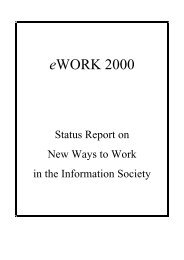Proceedings of 8th European Assembly on telework (Telework2001)
Proceedings of 8th European Assembly on telework (Telework2001)
Proceedings of 8th European Assembly on telework (Telework2001)
You also want an ePaper? Increase the reach of your titles
YUMPU automatically turns print PDFs into web optimized ePapers that Google loves.
70what, then, has changed?Any analysis must be rooted in an understanding that we still inhabit a material world in whichc<strong>on</strong>sumpti<strong>on</strong> <str<strong>on</strong>g>of</str<strong>on</strong>g> raw materials is still growing, manufacturing is still increasing at global level,ec<strong>on</strong>omic development in the developing world produces new jobs in the EU, regi<strong>on</strong>al ec<strong>on</strong>omicdifferences persist, the workforce remains differentiated with many low-skilled jobs producingand delivering ‘real’ goods and services and a substantial proporti<strong>on</strong> - usually a majority - <str<strong>on</strong>g>of</str<strong>on</strong>g> thepopulati<strong>on</strong> in any given place will be ec<strong>on</strong>omically dependent <strong>on</strong> activities which do not involve<strong>on</strong>ly the processing <str<strong>on</strong>g>of</str<strong>on</strong>g> informati<strong>on</strong> but the processing or delivery <str<strong>on</strong>g>of</str<strong>on</strong>g> physical goods or services inreal time and real space. c<strong>on</strong>sumpti<strong>on</strong> <str<strong>on</strong>g>of</str<strong>on</strong>g> raw materials still growing – an so are the traffic jams!The majority <str<strong>on</strong>g>of</str<strong>on</strong>g> the workforce will be anchored to particular, unduplicable physical locati<strong>on</strong>s.It is, however, <strong>on</strong>e <str<strong>on</strong>g>of</str<strong>on</strong>g> the great ir<strong>on</strong>ies <str<strong>on</strong>g>of</str<strong>on</strong>g> our time that they will not necessarily be doing so inthe places from which they originate. The globalisati<strong>on</strong> processes which have produced the newinternati<strong>on</strong>al divisi<strong>on</strong> <str<strong>on</strong>g>of</str<strong>on</strong>g> informati<strong>on</strong> processing work have also coincided with major migrati<strong>on</strong>s <str<strong>on</strong>g>of</str<strong>on</strong>g>people around the world. Increasingly we find that the jobs with the most intensive requirement forphysical co-presence are also those most likely to be carried out by migrants. Examples <str<strong>on</strong>g>of</str<strong>on</strong>g> theseinclude domestic or industrial cleaners, child-care workers, low-skilled assembly workers, janitorsand security guards, labourers <strong>on</strong> c<strong>on</strong>structi<strong>on</strong> sites, sex workers and service workers in hotels andfast-food chains.I have emphasised the persistence <str<strong>on</strong>g>of</str<strong>on</strong>g> this ‘rooted’ employment because it is so <str<strong>on</strong>g>of</str<strong>on</strong>g>ten renderedinvisible in discussi<strong>on</strong>s about the informati<strong>on</strong> society. However it must not be assumed that allwork will take this form. A substantial proporti<strong>on</strong> <str<strong>on</strong>g>of</str<strong>on</strong>g> employment, perhaps as much as 30% in themost developed ec<strong>on</strong>omies, already or potentially involves the processing <str<strong>on</strong>g>of</str<strong>on</strong>g> digitised informati<strong>on</strong>and is therefore capable <str<strong>on</strong>g>of</str<strong>on</strong>g> being relocated to any spot where the right infrastructure is to be foundin combinati<strong>on</strong> with a workforce with the requisite skills and abilities.We are therefore c<strong>on</strong>fr<strong>on</strong>ted with an entirely new situati<strong>on</strong>: the combinati<strong>on</strong> <str<strong>on</strong>g>of</str<strong>on</strong>g> telecommunicati<strong>on</strong>sand computing (telematics) is bringing about real changes in who does what work, where, whenand how and that there are new choices open to both employers and workers in the organisati<strong>on</strong><str<strong>on</strong>g>of</str<strong>on</strong>g> work in time and space.the EMERGENCE Projectthe project’s aimsThe EMERGENCE Project was set up, with funding from the <str<strong>on</strong>g>European</str<strong>on</strong>g> Commissi<strong>on</strong>’s Informati<strong>on</strong>Society Technologies (IST) Programme to:• Measure the extent <str<strong>on</strong>g>of</str<strong>on</strong>g> eWork• Identify the forms and characteristics <str<strong>on</strong>g>of</str<strong>on</strong>g> eWork• Identify favoured locati<strong>on</strong>s for each eActivity• Find reas<strong>on</strong>s for the choice <str<strong>on</strong>g>of</str<strong>on</strong>g> locati<strong>on</strong> or supplier• Explore the dynamics <str<strong>on</strong>g>of</str<strong>on</strong>g> relocati<strong>on</strong>• Investigate the employment implicati<strong>on</strong>s• Identify the c<strong>on</strong>straints and facilitators• Identify indicators for future modelling and tracking• Inform regi<strong>on</strong>al development strategies








